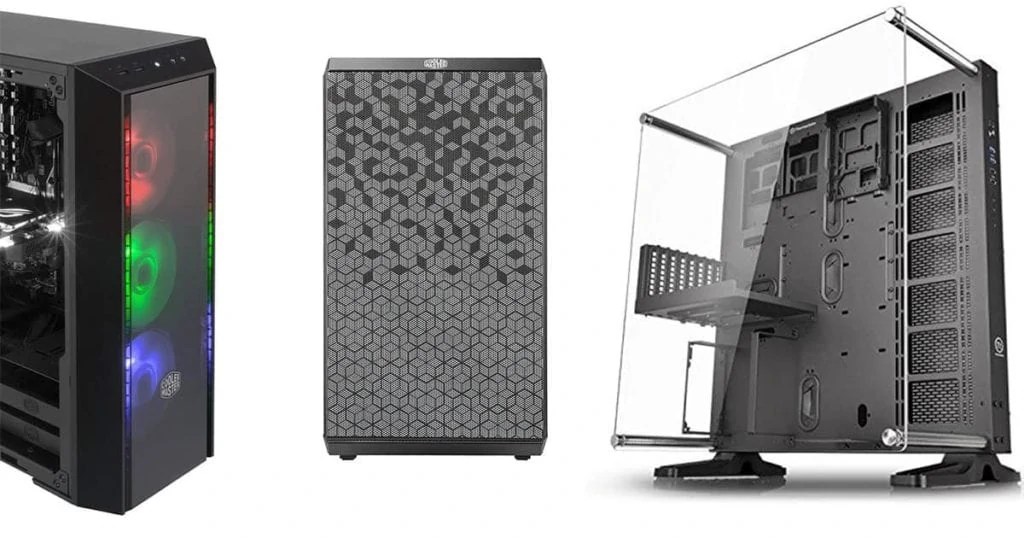What is the best available tempered glass PC case? The first thing to note is that having a tempered panel is almost purely aesthetic. There is no thermal or cooling benefit. And the noise levels are inaudibly different.
When looking for a case to show off your components and RGB, a tempered glass side panel is a must. But having the ability to see into your PC isn’t the only thing to look for when buying a case.
Thorough research of what’s currently available and years of building PCs has led me to suggest these cases for both new builders and veteran computer techs.
With that said, all these cases include a glass side panel, but their other features are what make them stand out.
Best Tempered Glass PC Cases
[table id=341 /]
Corsair’s 4000D Airflow – Best Overall
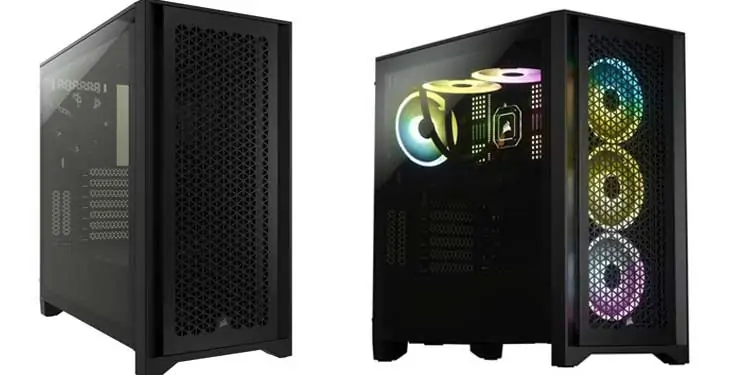
Corsair’s 4000D airflow is a case with an excellent price point of just under $95 on Amazon and Newegg. The case has a good set of features, a prominent tempered glass side panel, and one of the best airflow systems on the market.
With two pre-included Corsair 120mm AirGuide fans, a largely mesh exterior, and room for a 360mm radiator in front, your PC is sure to stay calm under heavy load.
Key Features
- Case Dimensions – 453mm x 230mm x 466mm
- Motherboard type – Micro ATX / ATX / Mini ITX / E-ATX (305mm x 277mm)
- Maximum GPU Length – 360mm
- Maximum PSU Length – 180mm (220mm if HDD cage removed)
- Maximum CPU Cooler Height – 170mm
- Expansion slots – 7+2 vertical
- Case Drive Bays – (x2) 2.5″ (x2) 3.5″
- Case Material – Steel
- Radiator Compatibility – Up to 360mm radiator
- Cooling System – (x6) 120mm or (x4) 140mm mounted fans
- Weight – 7.8 kg
Corsair also has a very well-engineered cable routing system to route your cables without revealing them. The case also has two mounting areas for SSDs and two HDD trays for your storage.
Something new PC builders will appreciate is the 4000D’s ease of access. The build process in one of these cases is extraordinarily smooth and straightforward.
When it comes to cons on the 4000D, there are only a few, and they are minor issues at that. The side panels can sometimes be stiff and difficult to remove, and the front I/O is simple. The front I/O only contains a single USB 3.0 port, a 3.1 USB type-c port, and an audio/microphone jack.
Corsair’s Crystal 570X RGB – Best Looking Tempered Glass Case
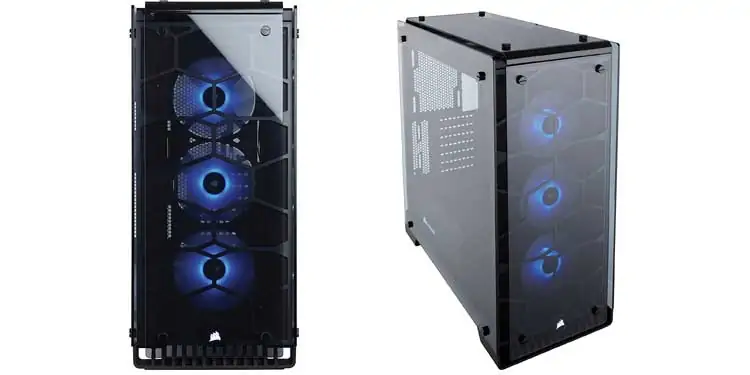
If you’re purely looking for something to show off, Corsair’s 570X RGB is an optimal choice coming in at around $200. With four tempered glass panels on all sides, this case can show off all of your RGB and expensive components.
The case also comes pre-equipped with a mount for vertically mounting your GPU. The prominent, large side panel offers excellent viewing angles.
Key Features
- Case Dimensions – 480mm x 234mm x 512mm
- Motherboard type – Mini-ITX / MicroATX / ATX (Up to 272mm)
- Maximum GPU Length – 370mm
- Maximum PSU Length – 225mm
- Maximum CPU Cooler Height – 170mm
- Expansion slots – 7
- Case Drive Bays – (x2) 2.5″ (x2) 3.5″
- Case Material – Steel
- Radiator Compatibility – Up to 360mm radiator
- Cooling System – (x6) 120mm or (x4) 140mm mounted fans
- Weight – 10.9 kg
With the 570X coming with almost all solid panels, you might think thermals and cooling would be an issue. However, this isn’t the case; the panels are raised from the surface.
Combined with the three included RGB fans, room for six case fans total, and room for a 360mm radiator, it keeps this case cool. Having all solid panels also helps to keep this case quieter than others.
Unfortunately, the good aspects of this case can somewhat be shadowed by the problems that come with it. The main problems stated in most reviews are the lack of luster cable management space and front I/O, containing just two USB 3.0 ports, and no reset button.
This is to be expected with a case made of glass, but some buyers also state they have had their cases come broken.
Dark Flash DLM21 Mesh – Best Budget Tempered Glass Case
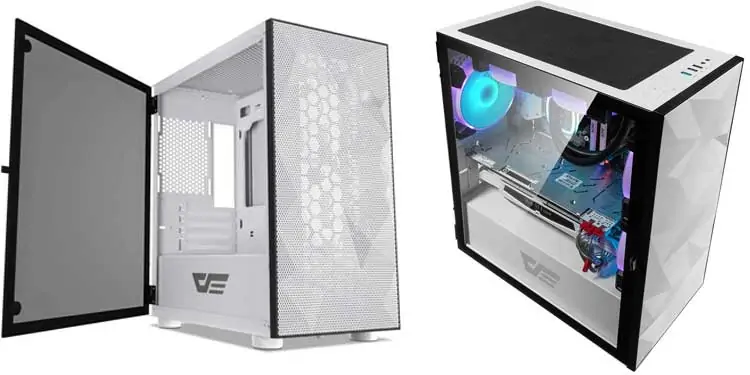
Working on a budget can sometimes mean making sacrifices in either performance or aesthetics. But with Dark Flashes DLM21 mesh, 65-75$ depending on where you buy from, will get you the best of both worlds at a low price.
This case has a lovely aesthetic with its polygon style front and multiple color choices. It also has good thermal performance, as the front panel is also entirely mesh.
Key Features
- Case Dimensions – 376mm x 208mm x 405mm
- Motherboard type – MATX / ITX
- Maximum GPU Length – 350mm
- Maximum PSU Length – 210mm
- Maximum CPU Cooler Height – 160mm
- Expansion slots – 4
- Case Drive Bays – (x3) 2.5″ (x2) 3.5″
- Case Material – Steel
- Radiator Compatibility – Up to 240mm radiator
- Cooling System – (x5) 120mm or (x2) 140mm mounted fans
- Weight – 4.8 Kg
The case at such a low price doesn’t lack any essential features. With four PCIe slots and vertical mounting options, and the ability to mount a 240mm radiator, this case is also spacious.
The front I/O even outshines some other more expensive cases. It includes a USB 3.0 port, two USB 2.0 ports, audio jacks, and a power and reset button. Something often left out of budget cases is a PSU shroud, the DLM21 includes a full-sized PSU shroud.
The tempered window is perfect for a cheap case and even slightly tinted with a swinging door-style opening.
With the case being on the cheaper side, there are some drawbacks. The case doesn’t have the best cable routing ability, allowing them to be seen from the front in some places. And the motherboard standoffs are not the greatest of quality. If you’re not a fan of logos the case also features a large logo on the PSU shroud.
Lian Li Lancool Mesh II – Best Tempered Glass Case For Airflow
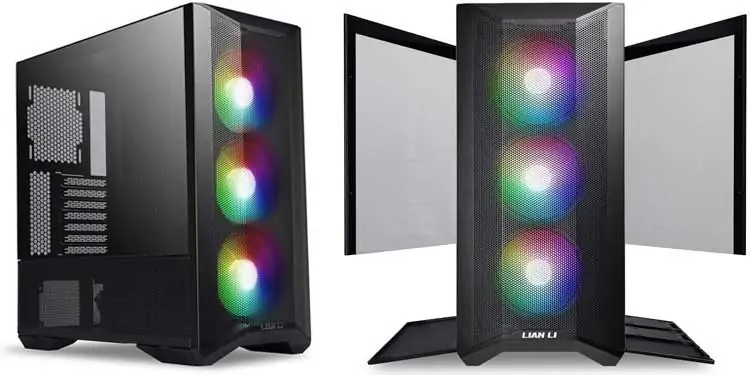
With the Lian Li Lancool Mesh II having cool in the name, as you’d expect this case is an airflow masterpiece. Costing around $110 – $120 on both Amazon and Newegg, Lian Li isn’t going to break your bank with this one either.
Airflow being the main selling point of this case, it doesn’t disappoint.
Key Features
- Case Dimensions – 478mm x 229mm x 494mm
- Motherboard type – E-ATX(width: under 280mm)/ATX/M-ATX/ITX
- Maximum GPU Length – 384mm
- Maximum PSU Length – 210mm
- Maximum CPU Cooler Height – 176mm
- Expansion slots – 7
- Case Drive Bays – (x6) 2.5″ (x3) 2.5″ or 3.5″
- Case Material – Steel
- Radiator Compatibility – Up to 360mm radiator
- Cooling System – (x8) 120mm or (x4) 140mm mounted fans
- Weight – 13.10 Kg
Being made of mesh and perforated surfaces, this included three 120mm ARGB fans provide adequate cooling out of the box.
Also built-in is a mesh shroud for the bottom left side and two modular PSU shroud covers, to help with GPU cooling.
In a stress test conducted by HardwareCanucks on the Lian Li and seven other competitors, The Lancool II was anywhere between 3-8 degrees celsius cooler on both the CPU and GPU temperatures.
Some other design features of the Lancool II include a large amount of cable management space, built-in ARGB control, two tempered glass side panels, and a sliding hard drive mount.
There are only two issues with this case, the bottom front panel has a sizeable non-mesh-covered hole on the underside. Allowing dust to get into the case. The other issue is that the slidable hard drive mount is non-removable.
Corsair Obsidian 1000D – Best Full Tower Tempered Glass Case:
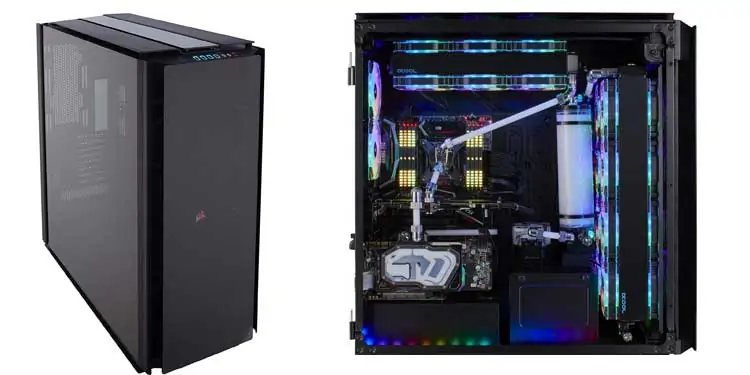
Are you building a massive, complex PC with lots of fans or even a custom loop? The Obsidian 1000D from Corsair will undoubtedly fit your needs. But costing over $500, it might not fit your budget.
This case is not for someone trying to build a simple gaming rig, or looking to go cheap.
Key Features
- Case Dimensions – 800mm x 505mm x 800mm
- Motherboard type – E-ATX(width: under 280mm)/ATX/M-ATX/ITX
- Maximum GPU Length – 400mm
- Maximum PSU Length – ATX – 225mm, SFX – 140mm
- Maximum CPU Cooler Height – 180mm
- Expansion slots – 10
- Case Drive Bays – (x6) 2.5″ (x5) 3.5″
- Case Material – Steel
- Radiator Compatibility – Up to 480mm radiator
- Cooling System – (x8) 120mm , (x3) 140mm , (x2) 120mm/140mm mounted fans
- Weight – 29.5 Kg
This case offers many unique features, from having two spaces for 480mm radiators and one for 420mm. If you’re someone looking to stream and game at high qualities, this case offers the ability to house two systems at once. It’s capable of fitting a full ATX and mini ITX system at the same time.
Installing radiators, in this case, is also quite simple because of the sliding radiator trays. For your radiators, other fans, and RGB lighting, the 1000D comes with a Corsair commander pro to control lighting and fan speeds.
Housing the cables needed to power two systems at once might sound complicated. But on the rear of the case, two french style doors have been installed to route cables easily.
Obviously, with such an impressive build, you’d want to show it off. The two large swinging glass panels on either side and one on the front allow for plenty of viewing angles.
With two systems in your case having double the ports only makes sense. The front I/O is RGB lit and contains four USB 3.0 ports and two USB type-c ports. While being a very well-designed and feature-ridden case, it does have its flaws.
This case comes with no fans and has many reviews and stories of poor quality control at this budget. The case can also be pretty complicated to figure out how to use effectively, and the panels and pieces can be challenging to remove.
Lian Li O11 Dynamic – Most Versatile Tempered Glass Case
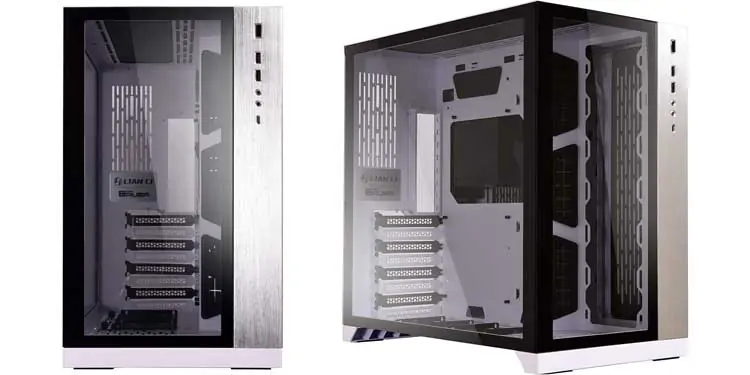
Lian Li didn’t leave anyone out from using this great-looking and well-functioning case. The O11 dynamic will work for really any type of build, custom loop, air-cooled, or just an AIO.
Many reviewers and users title this case as the overlocker’s dream with plenty of room for building a sleek design. The case is at under $130, which is a great price to pay for this astounding case.
Key Features
- Case Dimensions – 272mm x 446mm x 445mm
- Motherboard type – Micro ATX / ATX / Mini ITX / E-ATX
- Maximum GPU Length – 420 mm
- Maximum PSU Length – 255 mm
- Maximum CPU Cooler Height – 155mm
- Expansion slots – 8
- Case Drive Bays – (x4) 2.5″ (x2) 3.5″
- Case Material – SECC
- Radiator Compatibility – Up to 360mm radiator
- Cooling System – (x6) 120mm , (x3) 120mm or (x2) 140mm mounted fans
- Weight – 9.57 Kg
Der8auer, a popular overclocker in the PC community, worked in sync with Lian Li to design this case. With the front and side glass panels not having any layers behind them, fans are mounted on the inside right side of the case or the top.
The right panel of the exterior is perforated to allow airflow into the PC. This mounting area can also be used in water-cooled builds for the radiator. Note that both the left-side glass panel and perforated right-side panel are swappable.
For someone drawing a lot of power for their components, this case also has the option to use two power supplies, as there are two mounts. The cable management in this case is also made simple with the dual-frame leaving plenty of space.
When it comes to thermals, The O11 doesn’t have high temperatures despite the solid panels. Reviews and tests show the temps stay around 60c for the CPU and 50c GPU at max load.
The main complaints with this case are that there is no option for a rear-mounted fan, and many customers cite their cases having scratches or other damages upon arrival.
NZXT H510 Elite – Most Overrated
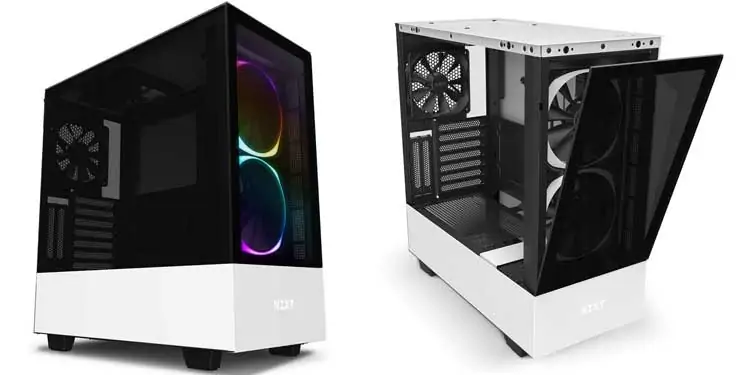
NZXT’s H510 has become a trendy case in the last few years, But there’s really no reason why. The case has a sleek and minimalistic design with one side glass panel and one in the front. It also comes with a large power supply bay, and those are really the only “outstanding” features.
And for under $150 range, this case is not the best choice for a tempered glass case.
Key Features
- Case Dimensions – 460mm x 210mm x 428mm
- Motherboard type – Micro ATX / ATX / Mini-ITX
- Maximum GPU Length – 338 – 368mm
- Maximum PSU Length – NA
- Maximum CPU Cooler Height – 165mm
- Expansion slots – 7+2 Vertical
- Case Drive Bays – (x3) 2.5″ (x3) 3.5″
- Case Material – SGCC Steel
- Radiator Compatibility – Up to 280mm radiator
- Cooling System – (x1) 120mm , (x3) 120mm or (x3) 140mm mounted fans
- Weight – 7.5 kg kg
Thermal and cooling problems have plagued this case since its release. High temperatures and high noise levels will be prominent in this case, with some users reaching CPU temps of 60°C at idle.
The included vertical GPU mounts are rendered almost useless because of the awful cooling capabilities. When using the included fans, there is also an unsteady and loud noise produced.
The H510 overall is rather bare-bones and doesn’t include very many features. Minimal cable routing, few spaces for storage, bad thermals, and many stories of cases coming with factory defects are all factors that play into this case being extremely overrated.
Be Quiet! Silent Base 802 – Best Quiet Tempered Glass Case
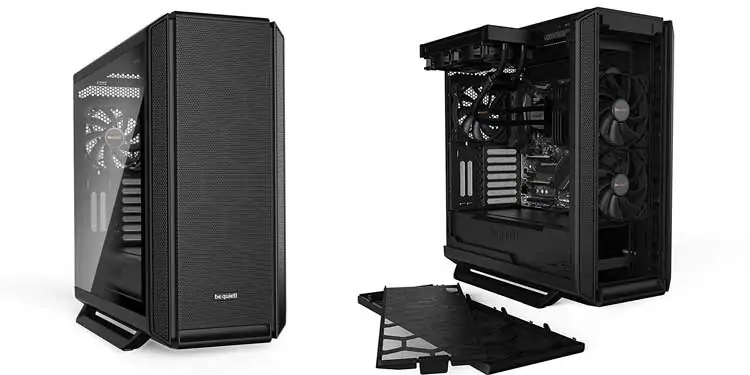
Be quiet! has not only engineered a nice-looking case but one with powerful functionality. The Silent base 802’s price range varies from 170-200$ depending on which version you choose.
This case does a lot of things right but its options and mechanical features outshine its gorgeous exterior.
Key Features
- Case Dimensions – 539mm x 245mm x 507mm//539mm x 281mm x 553mm(With Stands)
- Motherboard type – E-ATX (30.5 x 27.5cm) / ATX / M-ATX / Mini-ITX
- Maximum GPU Length – 432mm, 287mm with HDD cage
- Maximum PSU Length – 288mm
- Maximum CPU Cooler Height – 185mm
- Expansion slots – 7 + 2 vertical
- Case Drive Bays – (x7) 2.5″, (x3) 3.5″ , (x4) 3.5″or (x8) 2.5″
- Case Material – Steel
- Radiator Compatibility – Up to 420mm radiator
- Cooling System – (x3) Pure Wings 140mm , (x5) 140mm or (x5) 120mm mounted fans
- Weight – 13.15 kg
The 802 comes with inter swappable front panels, one solid and one mesh. Allowing for better airflow and cooling or a quieter system, also included are three pre-installed 140mm fans. If you prefer a quiet PC case, there is sound dampening foam installed into the case and mounts designed to eliminate vibration.
Other features include spring-assisted side panels, an invertible motherboard tray, a highly functional front I/O.
The case has a fan controller allowing for control of up to six fans at four speeds and an interchangeable top cover. The space for a 420mm radiator and built-in tinted, tempered window are also nice touches. There are few notable issues with this case, such as the weak adhesive and cluttered power supply spacing.
Thermaltake Tower 100 – Best Mini ITX Tempered Glass Case
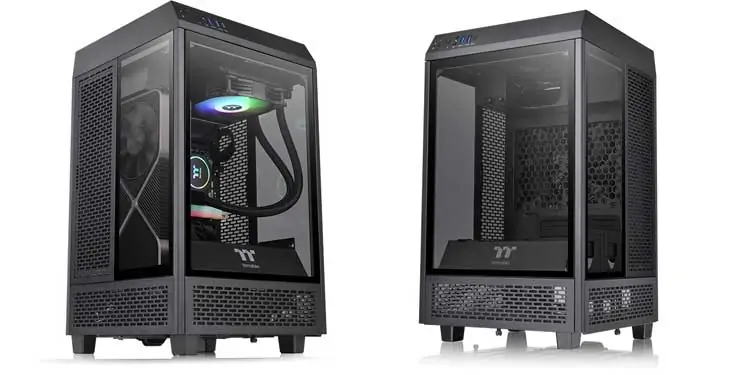
Thermaltake is known for making bigger cases, but with their Tower 100, they have gone on the opposite end of the size spectrum.
With an excellent price point for a unique mini case at just under $110 this case works well for any ITX build. Whereas other premium mini-cases can sometimes hurt your wallet.
Key Features
- Case Dimensions – 462.8mm x 266mm x 266mm
- Motherboard type – 6.7″ x 6.7″ (Mini ITX)
- Maximum GPU Length – 330mm
- Maximum PSU Length – 180mm
- Maximum CPU Cooler Height – 190mm
- Expansion slots – 2
- Case Drive Bays – (x2) 2.5″, (x2) 3.5″
- Case Material – SPCC
- Radiator Compatibility – Up to 120mm radiator
- Cooling System – (x3) 140mm or (x3) 120mm mounted fans
- Weight – 6.1 kg
With every panel being perforated and there being dust filters everywhere, this case stays not only cool but also fairly clean. Cooling and dust are two problems most other mini cases struggle with.
Getting panoramic views of your entire PC isn’t something even full-size cases usually do, but the Tower 100 offers terrific viewing angles. This is thanks to the three main tempered glass panels that make up the case’s square body.
This case doesn’t lack in any aspects considering its compact form factor. The case has a full front I/O, two included 120mm fans and even room for a full-size ATX power supply. Minor problems with this case include complicated cable routing, loud noise profile, and it’s slightly larger than most ITX cases.
Azza Pyramid – Most Unique Tempered Glass Case
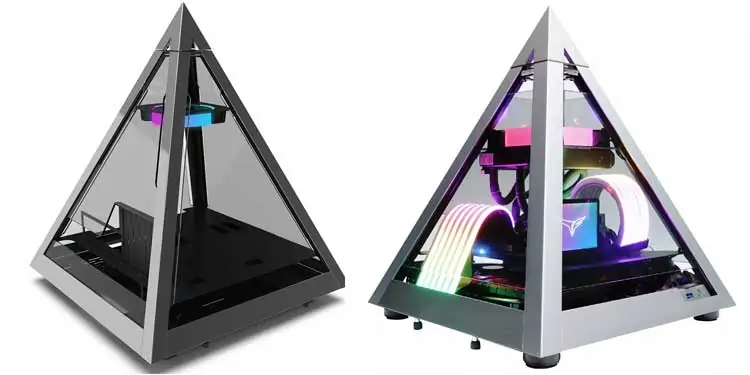
When it comes to practicality, by no means does this case fit that description. However, if you’re looking for something unique to show off, this case will definitely draw some attention. With this case also priced under $300 it is also not for those on a budget.
As far as features the case is pretty bland, with no exclusive features besides being a pyramid and having full 360-degree viewing angles.
Key Features
- Case Dimensions – 589mm x 490mm x 490mm
- Motherboard type – Micro ATX / ATX / Mini ITX / E-ATX (<300mm)
- Maximum GPU Length – 300mm
- Maximum PSU Length – NA
- Maximum CPU Cooler Height – 80mm
- Expansion slots – 2
- Case Drive Bays – (x2) 2.5″, (x1) 3.5″
- Case Material – Gray Anodized Aluminum
- Radiator Compatibility – Up to 360mm radiator
- Cooling System – (x1) 120mm AZZA Hurricane II ARGB Fan, (x4) 120mm mounted fans
- Weight – 14.1 kg
Cooling and airflow are also not going to be your friend with this build, with little room for fans and all solid panels, dust build-up is also prevalent. If you’re looking to throw a big GPU into this case you’ll be sad to find out it only supports up to a 300mm card.
However, this case does have vertical mounting abilities out of the box.
The case include a single 120mm fan and standard front I/O with two USB ports, a USB type-c port, and audio jacks. The case also houses room for an AIO to be added but won’t be provided much room to breathe causing the airflow to below.
Cable management can also be tight in this case especially when using an AIO, but if you’re just looking for a unique case to wow your friends this is definitely the one.
Finding the Right Tempered Glass PC Case
Well, folks, that was the 8 best models of tempered glass PC cases for different people with different needs. But don’t go yet!
If you still have trouble making up your mind or just want to get more tips before buying your first PC case, read on. The following section will answer your frequently asked questions and review how to pick the perfect case for your needs.
When it comes to choosing a case with a tempered glass side panel, the options are endless. All of the cases listed here have one thing in common, they all have glass panels, it’s their features that separate them. There are hundreds of options with glass panels, which is why finding what works for you and what fulfills the needs of your build is just as important.
When selecting a case, builders tend to try to find something affordable or on the cheaper end. While most cases aren’t too expensive, some of the nicer-looking and well-performing cases can be. Especially cases with tempered glass, are going to cost more than a case with just metal side panels.
Make sure to do some research on whatever case you do choose for your build. Ensure the size of your components is compatible with the case if the case has room to hide any extra cables you might have. And making sure the case has enough ports for all of the peripherals you’re going to be plugging into it.
Tempered Glass PC Cases vs Acrylic PC Cases
Tempered glass PC cases are considered the “Premium grade” in this industry. It has been tried, tested, and proven to be of superior quality to other PC cases.
Let’s put tempered glass, and acrylic PC cases head-to-head
Against Acrylic, tempered glass PC cases are:
- More scratch-resistant. This means you can wipe it with a cloth without the fear of any hairline scratches. No sweat.
- Looks way better. This just cannot be put in words. Tempered glass PC cases are simply more visually appetizing.
- More resilient. Acrylic PC cases can discolorize after some time or even warp under the immense heat. Tempered Glass PC cases have no such problem. They are low-maintenance machines.
Now that I have established that tempered glass PC cases are the go-to option, you may be thinking about that elephant in the room, price.
What Is the Right Price?
The price depends. A rough estimate would be from $30-$300, depending on what you’re looking for.
And yes, this is realistic. Take the Cougar MX 330-G, for example, you can find it online for as low as $40! Although tempered glass PC cases are the “premium grade” option, it doesn’t mean that they’re all expensive.
Of course, you should expect the more budgeted PC cases to have only one tempered glass pane. For four-paned tempered glass PC cases, the price should not exceed more than a few hundred dollars ($300), so start saving, and you will eventually afford it!
Some PC cases that exceed that price range, like the Corsair Obsidian Series 1000D, usually aren’t because of the tempered glass. These PC cases come with extra premium features, which is why they cost so much more.
Now that we’ve cleared money matters out of the way, which brand should you choose? Does the thickness of the tempered glass matter?
“Best” Brands of Tempered Glass PC Cases
There isn’t a “best” brand of tempered glass PC cases. Or maybe none of the big shots ever tried to compete for the title.
Popular PC case brands like Corsair, Phanteks and Cooler Master constantly fight to construct the “highest-performance” PC Case. Not so much of a PC case with the “best tempered glass”.
Regarding tempered glass PC cases, simply mentioning that the PC case has four tempered glass window panels is enough for most buyers.
Does Thickness Matter?
The only other thing PC Case companies may mention is the thickness of the tempered glass. A ballpark value will be from 0.3mm-0.6mm.
Generally speaking, thickness doesn’t matter.
Tempered glass which stays within this range of thickness is a good choice, giving enough protection without taking up too much space.
Watch out for thicker tempered glass PC cases, as those will be unnecessarily heavy. You’re buying a PC Case, not 90-pound weights!
Can Tempered Glass PC Cases Be Customized?
Tempered glass PC cases can be customized, but the glass cannot be reshaped. If you were to try, you should shatter the glass and ruin the tempered finish on it.
Sorry if I’ve shattered your hopes, modders. Unfortunately, tempered glass cannot be resized or skillfully cut into smaller pieces. Even a professional would fail if they tried.
The piece of glass is shaped and sized to the desired size before annealing it (heating and hardening it up). Then comes the tempering, and the glass becomes tempered glass—no turning back.
How should I clean my tempered glass case?
Cleaning your case regularly is very important. A mixture of dish soap and water will work just fine when lightly applied to the glass to clean the tempered glass. Premade solutions for this exact purpose also work well.
You can use a can of compressed air, or a low-pressure compressor to clean out the dust and debris that inevitably get into your PC. It is essential not to use a vacuum in your PC as this could ruin components.
Any More Downsides of Tempered Glass?
I hope this doesn’t come as a shock to you, but tempered glass can be broken. Although four times stronger than regular glass, tempered glass is, after all, still glass.
This doesn’t mean that a simple tap would break your fancy new tempered glass PC case. If you pull out a sledgehammer, though — well, that’s another story. The glass will shatter into a thousand tiny pieces.
The other downside is cleaning the glass. Most owners will find that the cleanup process is a lot harder than a piece of acrylic.
Do Tempered Glass PC Cases Get Hot?
Tempered glass will get hot if there’s a lot of heat churning around in your case. The best way to avoid this is with proper airflow. Plug in a few internal fans, and your glass’s temperature will quickly drop down to normal.
If you didn’t know, your PC’s fans should suck from the front and blow out the back. This ensures your case stays cool for as long as it’s on.
How Can You Tell If the Glass Is Tempered?
There are two major ways to tell if the glass, in your case, is tempered.
First, you can score a little line. This will ruin the final look of your glass, so I wouldn’t personally suggest it. The idea is that you can cut a line in your glass and look at how it was cut. If the score is bumpy and flaky, it’s tempered. If it’s really clean, then it’s probably acrylic.
The other option is to look at the corners. The tempering process will leave the pane with smooth and rounded corners. Run your finger across the corner and see how it feels.
Can Tempered Glass Case Shatter Easily?
It actually takes quite a bit for tempered glass to shatter. In this video, the presenter drops a pane face-down onto asphalt from about 6 feet and it doesn’t shatter. It isn’t until they drop it on-edge from 8 feet that it finally shatters.

